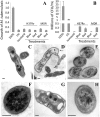1,4-Benzoquinone antimicrobial agents against Staphylococcus aureus and Mycobacterium tuberculosis derived from scorpion venom
- PMID: 31182590
- PMCID: PMC6600905
- DOI: 10.1073/pnas.1812334116
1,4-Benzoquinone antimicrobial agents against Staphylococcus aureus and Mycobacterium tuberculosis derived from scorpion venom
Abstract
Two 1,4-benzoquinone derivatives, found in the venom of the scorpion Diplocentrus melici following exposure to air, have been isolated, characterized, synthesized, and assessed for antimicrobial activities. Initially a white, viscous liquid, the extracted venom colors within minutes under ambient conditions. From this colored mixture, two compounds, one red, the other blue, were isolated and purified using chromatography. After a variety of NMR and mass spectrometry experiments, the red compound was determined to be 3,5- dimethoxy-2-(methylthio)cyclohexa-2,5-diene-1,4-dione, and the blue compound was determined to be 5-methoxy-2,3- bis(methylthio)cyclohexa-2,5-diene-1,4-dione. Because extremely small amounts of these compounds were isolated from the scorpion venom, we developed laboratory syntheses from commercially available precursors, allowing us to produce sufficient quantities for crystallization and biological assays. The red benzoquinone is effective against Staphylococcus aureus [minimum inhibitory concentration (MIC) = 4 µg/mL], while the blue benzoquinone is active against Mycobacterium tuberculosis (MIC = 4 µg/mL) and even against a multidrug-resistant (MDR) strain with nearly equal effectiveness. The bactericidal effects of both benzoquinones show comparable activity to commercially available antibiotics used against these pathogens and were cytotoxic to neoplastic cell lines, suggesting their potential as lead compounds for the development of novel antimicrobial and anticancer drugs. Importantly, the blue benzoquinone was also effective in vivo with mouse models of MDR tuberculosis infection. After treatment for 2 mo, four mice with late-stage active MDR tuberculosis had a significant decrease in pulmonary bacillary loads and tissue damage. Healthy mice served as negative controls and tolerated treatment well, without adverse side effects.
Keywords: Staphylococcus aureus; antimicrobial activity; benzoquinones; mycobacterium tuberculosis; scorpion venom.
Conflict of interest statement
The authors declare no conflict of interest.
Figures




References
-
- Epidemiología DGd , “Manual de Procedimientos Estandarizados para la Vigilancia Epidemiológica de la Intoxicación por Picadura de Alacrán” (Secretaría de Salud, Salud SdPyPdl, 2012).
-
- Espino-Solis G. P., Riaño-Umbarila L., Becerril B., Possani L. D., Antidotes against venomous animals: State of the art and prospectives. J. Proteomics 72, 183–199 (2009). - PubMed
Publication types
MeSH terms
Substances
LinkOut - more resources
Full Text Sources
Other Literature Sources
Miscellaneous

